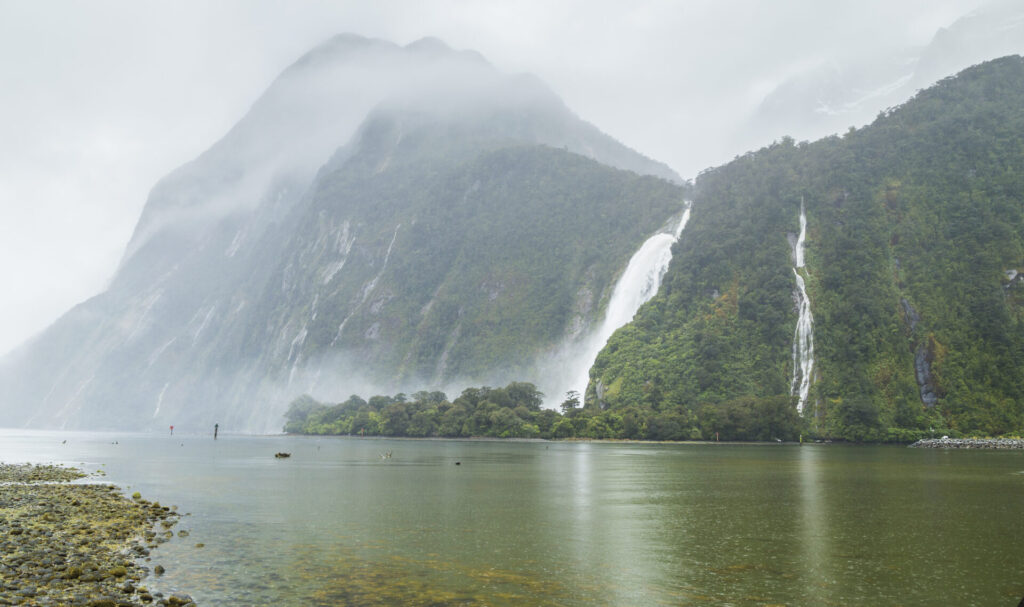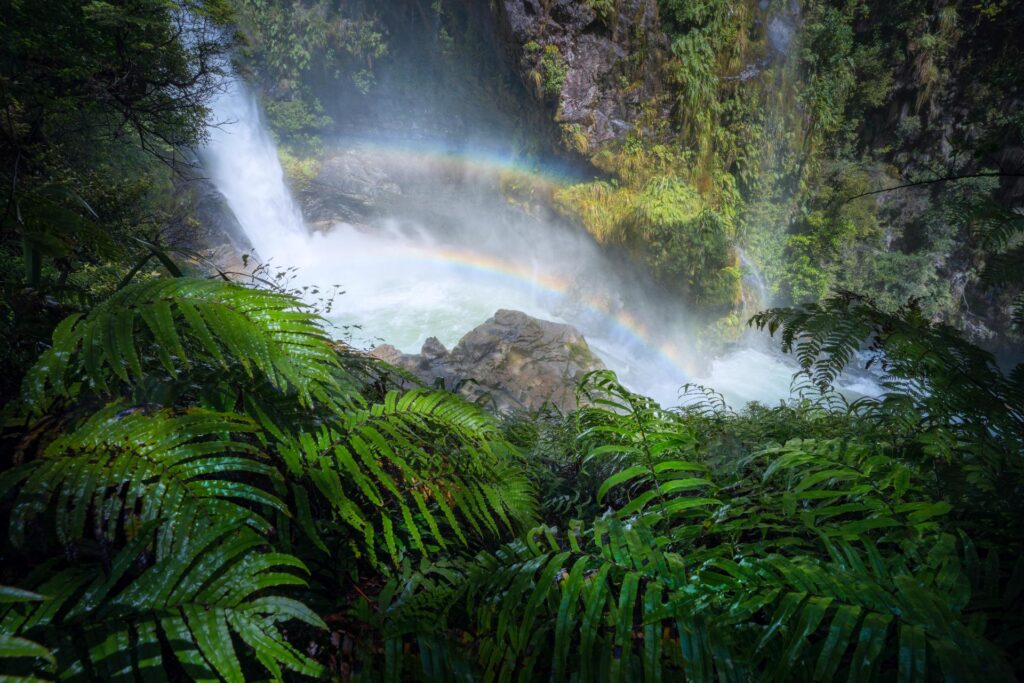Prepare for Milford
Piopiotahi Milford Sound is stunning in all weathers and seasons but it’s particularly magical and moody when shrouded in mist or rain. In fact, the waterfalls become even more impressive during or after rainfall, with hundreds of temporary cascades forming along the mountainsides.
However, travelling to this remote destination requires careful planning. It’s essential to understand the potential hazards and risks and prepare accordingly. Stay informed by checking the latest weather forecasts and Milford Road status updates before setting out and view the Milford Sound webcam.
Weather & seasons
Renowned for its spectacular scenery, this region is also one of New Zealand’s wettest, with a huge array of waterfalls, lakes, and rivers—each a testament to the extraordinary rainfall that averages over 7 metres a year.
No bad weather, just the right gear!
No matter when you visit, just remember there’s no such thing as bad weather in Piopiotahi Milford Sound, only the wrong gear! Here’s what you can expect throughout the year.
Long summer days mean more time to soak up the beauty of the fiord and enjoy warmer temperatures up to 27°C (81°F). However, summer rainfall is similar to that in winter, so be prepared for sudden showers.
Be sun smart – New Zealand has relatively little air pollution and less ozone, which makes the UV rays in our sunlight very strong. In warmer months (September to April) you can get burnt quickly without sunscreen or other sun protection. Take particular care between 10am and 4pm, even on cloudy days. Stay in the shade whenever possible, wear a shirt, hat and sunglasses, and use SPF 30+ sunscreen.
The nights can get surprisingly chilly, dropping to around 7-8°C (45°F), so packing a jacket is a must. It’s also the time for sandflies so bring some insect repellent.
Summer is considered peak visitor season so it’s best to book accommodation and tours well in advance.
Autumn is a magical time to visit. The change of seasons is marked by stunning landscapes and vibrant colours contrasting against the towering mountains and deep blue waters.
Daylight saving ends on the first Sunday of April; visit before then to enjoy the longer evenings and fewer visitors.
Temperatures start to dip below 20°C (68°F) by late April, with chilly nights in May. Historically, May experiences some of the highest rainfall, so bring warm wet weather gear.
During New Zealand’s winter months, temperatures in Piopiotahi Milford Sound can get pretty cold, with the average high ranging from 6-11°C (42-53°F).
Snow frequently transforms the landscape into a stunning winter wonderland, so dress warmly and allow extra time for travel.
Snow and ice can also cause road closures so keep an eye on updates if driving. If you’re not confident driving alpine roads in icy conditions, consider taking a tour so that you can sit back, relax and enjoy the views. If renting a car, make sure it’s suitable for winter conditions, carry snow chains and know how to use them. Here’s a video of how to fit snow chains.
Winter is quieter, perfect for enjoying more leisurely cruises and off-peak rates. Wildlife remains active, so keep an eye out for playful dolphins and lounging fur seals.
Spring in Piopiotahi Milford Sound is a season full of surprises. One day might be frosty, while the next could be beautifully sunny. By October, daytime temperatures often climb to a pleasant 20°C (68°F), and nights remain comfortably mild. With daylight saving beginning on the last Sunday of September, evenings gradually lengthen as summer approaches.
The changing season brings a burst of colour, with Southern Rātā in bloom and lupins lining the roads into the fiord. Just be mindful that waterways may swell from melting snow, so exercise caution while hiking.
Spring is also the most exciting time for wildlife watching, as you might spot cute seal pups and baby dolphins.
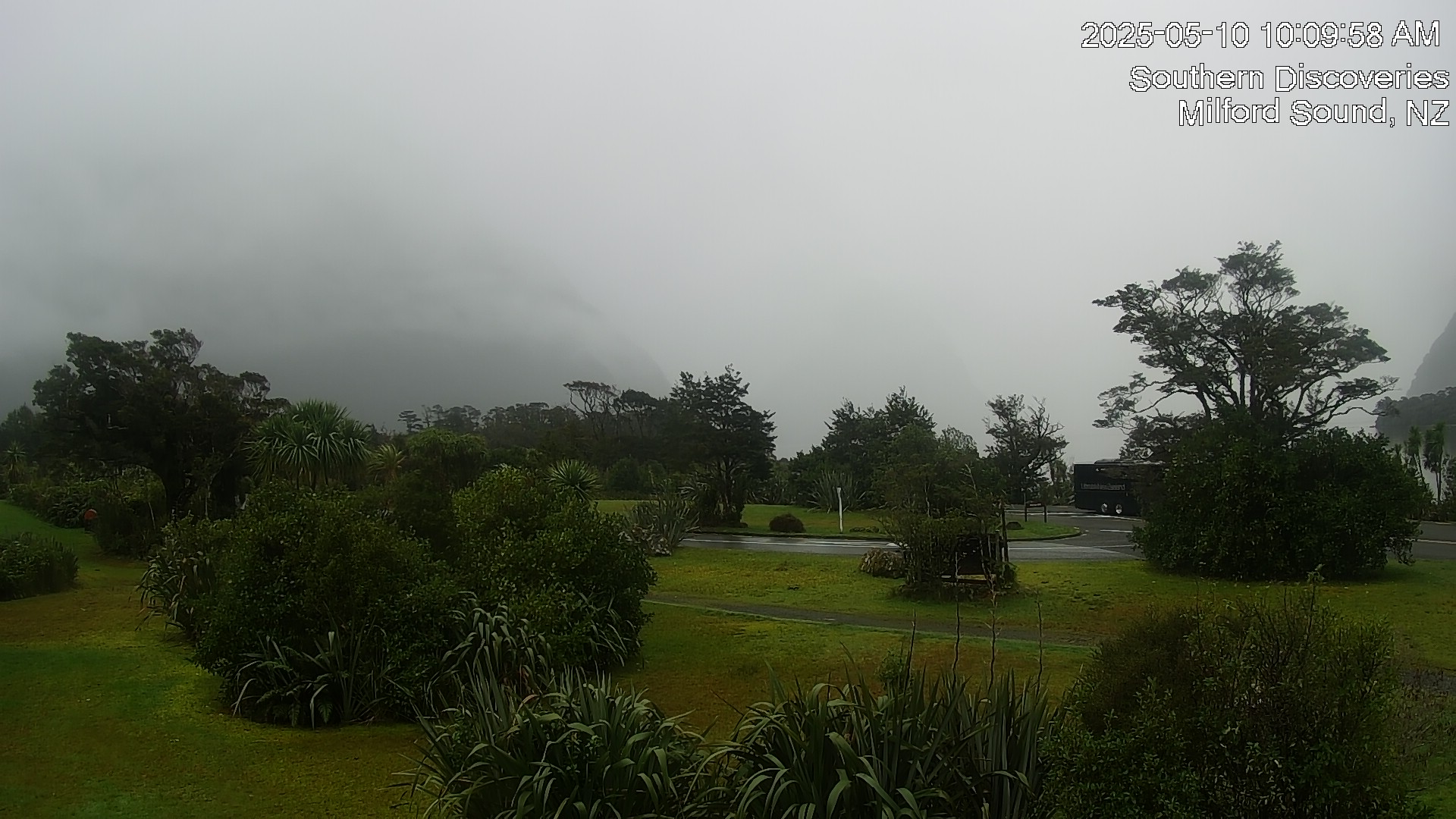
Live webcam of Milford Sound from Southern Discoveries.
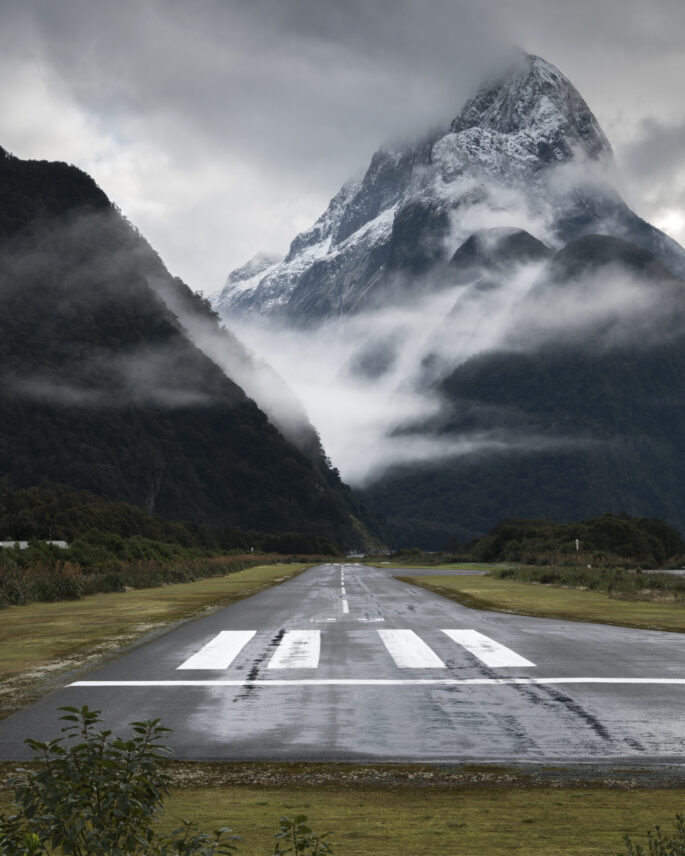
Top 10 visitor tips
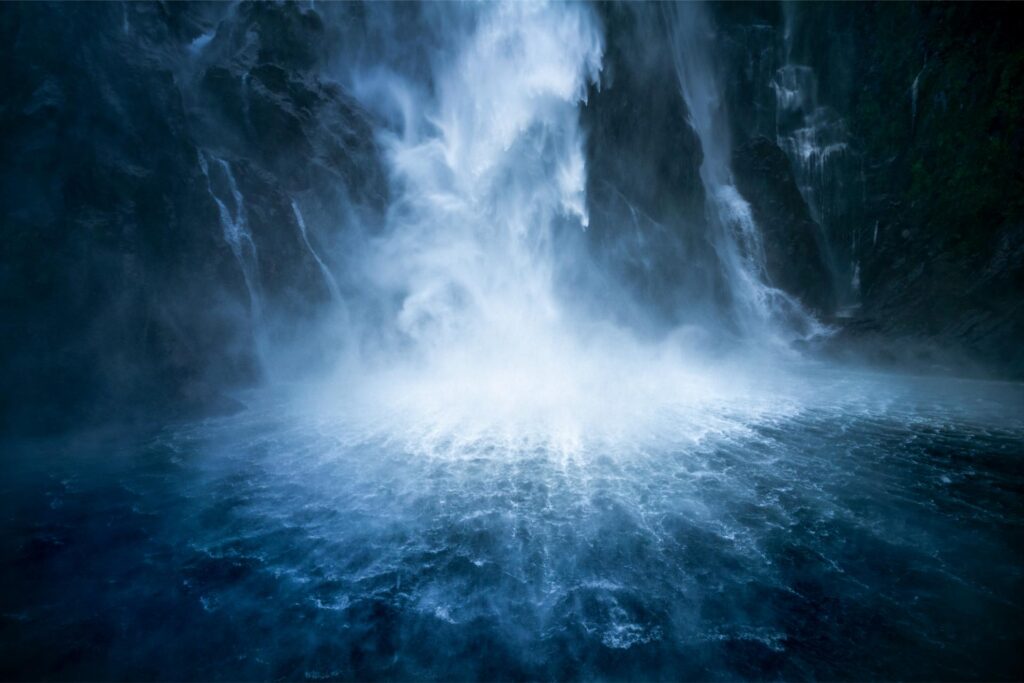
Visiting Piopiotahi Milford Sound is an unforgettable experience so consider staying overnight (or in nearby Te Anau) to make the most of your time. Exploring early in the morning or later in the afternoon, outside peak visitor hours, makes for a more relaxed experience and often stunning light for photography.
Book your accommodation, cruises and tours in advance – especially during peak seasons.
The Milford Road is a remote alpine highway so check the latest weather and updates, drive to the conditions, follow the road signage, carry chains in winter and know how to fit them. To relax and make the most of the scenery – take an organised tour – there are plenty of options and excellent local companies to choose from.
Keep an eye on weather forecasts before your visit. Heavy rain can create spectacular waterfalls, but it may also affect visibility and travel conditions. Be mindful of snow or ice and always allow extra time if driving.
Check out the Southern Discoveries webcam.
The weather can change quickly. Wear layers to stay comfortable, and always bring a waterproof jacket, even in summer.
There are no shops or petrol stations and only limited mobile phone coverage between Te Anau and Piopiotahi Milford Sound, so fuel up in Te Anau and bring water and snacks with you. There are public toilets in Te Anau and on the Milford Road at Knobs Flat.
The journey is an experience in itself so allow plenty of time for stops at lookout points and short walks along the way.
You will be sharing the road with other cars, campervans and large tour coaches. Most people plan their trip to Milford Sound to coordinate with cruise times and traffic can often be heavy. If you’re driving slower than the speed limit and there are vehicles following you, please pull over where it’s safe to let them pass.
In warmer months, be prepared for sandflies, which come out mostly at dawn and dusk. They are not a public health risk but can be a nuisance. Bring insect repellent to keep them at bay. Find out more about them here.
Help us protect this special place by following the Tiaki Promise. Stay on marked paths, don’t disturb the local plants or wildlife, and please take your rubbish with you.
Guidelines & regulations
To protect this UNESCO World Heritage Site and its unique marine environment, a set of guidelines and regulations is in place for visitors to Piopiotahi Milford Sound and the surrounding Fiordland National Park.
While Fiordland is known for its rainfall, wildfire is still a risk and can happen any time of year. Open fires are prohibited in the Fiordland National Park for this reason.
This area is home to a range of wildlife and some of New Zealand’s most iconic and unique plant and animal species are endangered, including the kiwi and takahē. Help to protect our natural world with these simple actions while travelling around our beautiful country.
Dogs are not permitted in the national park and nature reserve. While some hunting areas and walking tracks allow dogs under controlled circumstances, these are not accessible from Milford Road. For more details, visit the DOC website.
Because of its location within a national park, and a UNESCO World Heritage Site, freedom camping at Milford Sound is strictly forbidden. Please use the registered campsites along the Milford Road.
All vessels entering Milford Sound harbour must comply with the Harbour Rules. For more information on keeping the marine reserve pest-free, visit Protect Fiordland.
Discharging waste along Milford Road or within the national park is prohibited. Ensure you take all waste with you.
Coaches entering Piopiotahi Milford Sound must adhere to the Coach Park Policy.
Aircraft require a DOC landing permit or ‘concession’ to land at Piopiotahi Milford Sound Aerodrome. Refer to the Civil Aviation Authority’s Good Aviation Practice Milford Guide for more details.
Drones are prohibited in Piopiotahi Milford Sound and Fiordland National Park. Check the DOC website for more information.
Certain areas are designated as no-anchoring zones to protect sensitive marine life and the sea bed. Information about no-anchoring areas can be found in the Fiordland User’s Guide.
The Piopiotahi Marine Reserve is a no-take zone, which means that fishing is not allowed within its boundaries. There are also restrictions on the size and number of certain types of fish in the area that you can catch. Visit the Ministry for Primary Industries website to familiarise yourself with these regulations before you start fishing.
Members of Ngāi Tahu Whānui may collect pounamu and specified marine resources with the proper resource consents and/or authorisation by the kaitiaki rūnaka. Collection must be done by hand, with minimal disturbance, and limited to what can be carried in one trip.
Five designated areas within four marine reserves are available for commercial rock lobster fishers to store live lobsters caught outside the reserves, as well as inoperable lobster pots (with doors open). These areas are located in the following marine reserves: Hawea (Clio Rock), Kahukura (Gold Arm), Taumoana (Five Fingers Peninsula), and Te Tapuwae o Hua (Long Sound).
Please note that these storage areas are not accessible to recreational fishers. Visit the Ministry for Primary Industries website for more details.
Recreational, educational, and scientific activities are welcome, provided they do not disturb local plants, wildlife or natural features. A DOC permit is required for any scientific research within the reserve.
